Table of contents
Blackberries ( Rubus sectio Rubus L., Rubus fruticosus agg.) are a refreshing ingredient in fruit salads or desserts when eaten raw. In addition to wild blackberries , there are also commercially grown blackberries and blackberries grown in organic quality.
Use in the kitchen
Raw blackberries are juicy and tasty. The taste of blackberries is very varied. The sweet, aromatic fruits often have a sour note. Some describe the blackberry taste as a mixture of grapes, plums, apples and coconut. The slightly smaller, wild blackberries are often much more aromatic than cultivated varieties. Blackberries look similar to black mulberries.
Can you eat blackberries raw? Organic blackberries are suitable for eating fresh, but also for smoothies or as a topping for pea muesli. Blackberries are also used to make jam, jelly, chutney, sorbet, juice, syrup, wine and liqueur. They are also popular as an ingredient in muffins or as a cake topping. Fruit vinegar, punch or fruit salads are often flavoured with raw blackberries.
Similar to theraspberry ( Rubus idaeus), not only the berries are used here: the blackberry leaves are also used to make tea because of their pleasant taste. Fermented blackberry leaves are a substitute for Chinese tea (black tea): this tea is often sold as a theine-free breakfast tea. 1 The flowers of the young plants are also suitable for tea, as a flavoring or as a decoration on desserts. Dried blackberries can also be brewed as a tea. 2
Vegan recipe for quick blackberry ice cream
Ingredients (for 2 people): 2 ripe bananas, 400 g blackberries.
Preparation: Peel the bananas, cut into pieces and place in the freezer for 1-2 hours. Wash the blackberries, drain well and puree in a blender. Then pass the blackberry puree through a sieve until only blackberry seeds remain in the sieve. Put the frozen bananas and the seedless blackberry puree in a blender and puree finely. Enjoy the blackberry ice cream immediately. The ice cream is already sweet thanks to the ripe bananas and does not require any additional sweeteners.
Vegan recipes with blackberries can be found under the note: " Recipes that have the most of this ingredient ".
| Not only vegans or vegetarians should read this: Vegans often eat unhealthily. Avoidable nutritional mistakes. |
Purchasing - Storage
Fresh blackberries are available almost all year round from supermarket chains such as Coop, Migros, Denner, Volg, Spar, Aldi, Lidl, Rewe, Edeka, Hofer and Billa thanks to long-distance imports. Central Europe offers an excellent climate for blackberries, which is why you can buy them from regional cultivation in the season from July to October 16. Conventional blackberries often contain pesticide residues, which is why we recommend organically grown berries. Organic berries can be found in regular supermarkets as well as in organic supermarkets such as Denn's Biomarkt and Alnatura.
The availability of blackberries varies depending on the size of the store, catchment area, etc. Our recorded food prices for the DA-CH countries can be found above under the ingredient image - and by clicking you can see their development at different suppliers.
Found in the wild
The blackberry can be found in forests, hedges, rubble heaps, roadside embankments and heathland. 3 The wild, thorny shrub has prickly, toothed leaves and purple-black aggregate drupes. 4 All blackberry species, whether wild or cultivated, are non-poisonous, including their leaves.
When do blackberries bloom? The flowering period is not uniform. The main flowering period is from May to the end of July, but they bloom into winter. On one bush you can find flowers, unripe and ripe berries at the same time. 3
Storage tips
Fresh blackberries should be used very quickly. They do not ripen, so you should only harvest ripe berries. If you still want to store them, lay them as flat as possible in small bowls so that they do not squash each other. Bruises can lead to mold formation. They will last for around two days in the fridge. Fresh blackberries can be best preserved by freezing.
Ingredients - Nutritional values - Calories
100 g of blackberries (organic?) have an energy content of 43 kcal. The fat and protein content is very low at 0.5 and 1.4 g. Blackberries contain approx. 9.6 g of carbohydrates and 5.3 g/100g of dietary fiber in the form of soluble and insoluble dietary fiber. 5
Blackberries contain 0.65 mg of manganese per 100 g, which corresponds to 32% of the daily requirement.Raspberries (0.67 mg/100g) and sea buckthorn berries (0.60 mg/100g) have a similar content. Herbs and spices contain a lot of manganese, as do wheat germ (13 mg), wheat bran (12 mg) and teff (9.2 mg/100g). 5
Fresh blackberries contain 20 µg/100g of fat-soluble vitamin K, which corresponds to 26% of the daily requirement.Blueberries have a similar content (19 µg/100g). Green vegetables such as chard (830 µg) and kale (705 µg) contain particularly high levels of this vitamin. 5
Blackberries are known for their vitamin C (ascorbic acid) content, although this is only 21 mg/100g, which is 26% of the daily requirement. Gooseberries and raspberries have a little more at around 27 mg. Sea buckthorn berries have a very high vitamin C content at 450 mg. But vegetables such as yellow peppers also have high levels (184 mg/100g). 5
Blackberries do not contain a lot of folate (folic acid) at 25 µg/100g. Pulses (e.g. mung beans 625 µg; chickpeas 557 µg or lentils 479 µg) provide a lot of folate. 5
Also present in smaller amounts are vitamin E, potassium, magnesium, pantothenic acid and zinc. 5
The complete ingredients of blackberries, the coverage of the daily requirement and comparison values with other ingredients can be found in our nutrient tables. In the article Nutrients explained you will get a detailed insight into the topic.
Ratio of omega-6 (LA) to omega-3 fatty acids (ALA) in berries
Berries and wild berries usually have a very good ratio between LA (linoleic acid) and ALA (alpha-linolenic acid). In general, berries have a low fat content and the amounts of omega-3 and omega-6 are accordingly low. In relation to the total fat content, however, the polyunsaturated fatty acids make up a high proportion.
The body uses alpha-linolenic acid to produce other omega-3 fatty acids (EPA and DHA), which have an anti-inflammatory effect, while linoleic acid is used to produce arachidonic acid, which has an inflammatory effect. The good ratio of omega-6 to omega-3 is another reason why the berries are considered a very healthy food.
Information on individual values of ALA and LA (source: USDA, Önwt, Debinet):
Berry (raw) | L.A. (g/100g) | ALA (g/100g) | Ratio LA:ALA | Total fat (g/100g) | source |
2.6 | 1.8 | 1.5:1 | 7.1 | Önwt | |
0.6 | 0.5 | 1:1 | 1.7 | Önwt | |
blackberry | 0.19 0.4 0.36 | 0.09 0.3 0.26 | 2:1 1.25:1 1.3:1 | 0.34 1.0 1.0 | USDA Önwt Debinet |
Forest Blackberry | 0.4 | 0.3 | 1.25:1 | 1.0 | Önwt |
0.2 | 0.2 | 1:1 | 0.5 | Önwt | |
0.3 | 0.2 | 1.5:1 | 0.7 | Önwt | |
0.2 0.22 | 0.2 0.15 | 1:1 1.5:1 | 0.6 0.6 | Önwt Debinet | |
0.25 0.1 | 0.13 0.1 | 2:1 1:1 | 0.46 0.3 | USDA Önwt | |
Forest Strawberry | 0.1 | 0.1 | 1:1 | 0.4 | Önwt |
Forest Raspberry | 0.1 | 0.1 | 1:1 | 0.3 | Önwt |
Boysenberry | 0.11 | 0.08 | 1.5:1 | 0.3 | Debinet |
0.11 | 0.07 | 1.5:1 | 0.26 | USDA | |
0.09 | 0.06 | 1.5:1 | 0.21 0.4 | USDA Debinet | |
0.27 | 0.05 | 5:1 | 0.4 | USDA | |
0.05 0.04 | 0.04 0.03 | 1:1 1.25:1 | 0.13 0.2 | USDA Debinet |
Health effects
What are blackberries good for? Blackberries contain vitamin C (ascorbic acid), which is a well-known antioxidant. Blackberries and blackberry juice are antioxidants and can bind reactive nitrogen and oxygen compounds (free radicals). This protects the body from oxidative stress, which promotes cardiovascular diseases, cancer, neurodegenerative diseases and inflammation, among other things. Antioxidants alleviate cell and skin aging, protect against endothelial dysfunction and vascular failure, and thus promote health. 8
In a study with 27 male subjects, it was found that regular consumption of blackberries increased fat burning (fatty acid oxidation). In addition, an increased sensitivity to the pancreatic hormone (I) was found, which is why the increase in the hormone was less after eating. 9
There are currently no studies on the antimicrobial effects of blackberry tannins, although blackberries are a rich source of ellagitannins. Raspberry tannins have been shown to have antimicrobial effects against staphylococci and salmonella in animal studies, so this may also apply to blackberry tannins. 7
Blackberries contain phytochemical compounds that have neuroprotective effects. An animal study investigated their potential use as a treatment for Alzheimer's disease. In fact, the memory performance of rats improved when they were fed blackberries for several days. An improvement in functions in the hippocampus, which are affected by Alzheimer's disease, was also observed. 22
Secondary plant substances
Many of the health effects of blackberries can be attributed to the secondary plant substances they contain. Our article on secondary plant substances provides an overview of the classification of substance groups, their occurrence in foods and possible effects on humans.
The antioxidant effect of the blackberry is based on the high content of anthocyanins and ellagitannins. 7 Other secondary plant substances are: quercetin, gallic acid, cyanidin, polyphenols. 7
Studies show that the amount and composition of secondary plant substances depends on the variety. 23
However, it should be noted that the composition of secondary plant substances in blackberries can vary depending on the variety, time of harvest and growing conditions. Therefore, quantities are only of limited use and should only be understood roughly.
Dangers - Intolerances - Side effects
When picking berries in the wild, it is important to always wash them before eating them. Fruits close to the ground may contain dirt or parasites. Infection with the eggs of the fox tapeworm ( Echinococcus multilocularis) is rare, but still possible. It can cause serious liver damage. Not only foxes, but also dogs and cats can be carriers. 10
Folk medicine - natural medicine
The blackberry bush has been known in folk medicine since ancient times, and the Greek poet Aeschylus and the doctor Hippocrates described the blackberry as a medicinal plant. 1,11 Blackberries and blackberry leaves are said to have a calming effect. Due to their tannins, they are used as an astringent against diarrhea or to treat inflammation in the mouth and throat by gargling. 2
Blackberries and blackberry leaves have not been studied by either the HMPC or ESCOP. 20 Commission E has published a monograph on blackberry leaves. 19 The drug name is Rubi fruticosi folium, syn. Folia Rubi fruticosi.
Ecological footprint - animal welfare
The ecological footprint of a food depends on factors such as the type of agricultural production (conventional vs. organic), seasonal, regional or domestic production or import by truck, ship or plane, different types of packaging and whether the food is fresh or frozen.
The Danish climate database CONCITO comes up with a CO 2 footprint of 1.17 kg CO 2 eq/kg for blackberries. This is comparable to blueberries and raspberries (1.03 kg CO 2 eq/kg), while strawberries only have 0.57 CO 2 eq/kg. 6 In European supermarkets, blackberries are very popular alongside raspberries and strawberries, even in the winter months. Then, however, blackberries mainly come to Europe from other continents, which means long transport routes and therefore emissions. In addition to cultivation and transport, the type of packaging also influences the CO 2 footprint. The greatest potential for saving emissions lies, for example, in replacing PET trays with cardboard packaging. Ideally, you buy organic blackberries seasonally and as regionally as possible.
Data on the water footprint of blackberries are not yet available. For comparison, the water consumption of other berries: raspberries 413 l/kg; strawberries 347 l/kg and blueberries 845 l/kg. 18
For detailed explanations of various sustainability indicators (such as ecological footprint, CO2 footprint, water footprint), see our article: What does the ecological footprint mean?
Animal protection - species protection
Wild blackberries are ideal sources of food for animals. Not only bird species such as blackbirds, song thrushes and blackcaps love blackberries, but also the hazel dormouse and the edible dormouse appreciate the vitamin-rich fruits.
Worldwide occurrence - cultivation
The exact origin of the blackberry is unknown. Wild forms are found in Eurasia and North America. Today, the blackberry is widespread in temperate zones worldwide, including the southern hemisphere. The climbing or upright bushes often have thorns. Varieties without thorns are usually used for commercial cultivation or in the garden.
In 2005, Europe, the United States and Mexico were the main producers of blackberries. They are also grown in Asia, South America, Oceania and Africa, but in smaller quantities. 21 Wild blackberries are also available.
Cultivation - Harvest
Blackberries are robust and grow quickly. The bush prefers sunny to partially shaded locations, which is why they are found in light forests or on the edges of forests. The soil should be rich in nutrients. Daily watering is necessary at high temperatures, as the bush needs a lot of water. In spring, the blackberries should be fed with an organic universal fertilizer or organic berry fertilizer. 16
How and when should you prune blackberries? Regular thinning and removing suckers prevents the growth of undergrowth. Cut off worn-out (two to three year old) branches at the ground and shorten the new shoots to around 2-5 branches. 12
Possible confusion
The blackberry ( Rubus fruticosus agg.) can easily be confused with the dewberry (or field blackberry), but it does not pose a danger. Rubus caesius is very widespread. Its berries are a little smaller than those of the blackberry, but very plump and juicy. The hairy, creeping shrub can reach a height of up to 40 cm, the thorns are soft and bristle-like. 4
The loganberry ( Rubus x loganobaccus) was crossed from a blackberry species and the raspberry. This variety arose by chance in California, probably from Rubus ursinus and the raspberry variety "Red Antwerp". 14 Its fruits are elongated red aggregate drupes with a sour taste. The name comes from JH Logan, an American judge.
The boysenberry ( Rubus ursinus x idaeus) is an American hybrid between the loganberry and a blackberry species. 15 The shrub and the berries resemble the blackberry.
Further information
The genus Rubus belongs to the rose family (Rosaceae). Within this genus, the section Rubus sectio Rubus, the blackberries, is known. This is a collective species that includes several thousand small species, varieties and hybrids. The collective name is Rubus fruticosus agg. and sometimes Rubus fruticosus L. 3,12 It is difficult to distinguish between the individual species. Well-known small species are: Armenian blackberry (garden blackberry, Rubus armeniacus Focke), dewberry (Rubus caesius) and hazel leaf blackberry ( Rubus corylifolius agg.). 13
The genus Rubus also includes raspberries ( R. idaeus), cloudberries ( R. chamaemorus) and arctic raspberries ( R. arcticus).
How can you remove blackberry stains? Rinse the stain with plenty of water. Do not rub, otherwise the stain will get bigger. Soak the clothing in soapy water or vinegar water (not suitable for wool or silk). Wash the clothing immediately in the washing machine after pre-treatment.
Alternative names
Popular trivial names are: Brambeere, Bramel, Brämel, Brombesing, Bromedorn, Bromelbeere, Brumenbeere, Braunbeere, Frombeere, Hirschbollen, Kratzbeere, Kratzelbeere, Moren, Nurr, Rahmbeere 17, Schwarzbeere, Feldschwarzbeere, Hundsbeere, Kroatzbeere, Schwarze Haubeere. 3
The blackberry is called blackberry or brambleberry in English, the blackberry bush is called bramble bush or blackberry bush.
Bibliography - 23 Sources
| 1. | Niederegger O, Mayr C. Heilpflanzen der Alpen. Tyrolia: Innsbruck. 2006. |
| 2. | Fleischhauer SG, Guthmann J, Spiegelberger R. Enzyklopädie Essbare Wildpflanzen. AT Verlag: Aarau. 4. Auflage. 2018. |
| 3. | Pahlow M. Das grosse Buch der Heilpflanzen. Gesund durch die Heilkräfte der Natur. Nikol: Hamburg. 2013. |
| 4. | Mabey R. Essbar. Wildpflanzen, Pilze, Muscheln für die Naturküche. Haupt: Bern, Stuttgart, Wien. 2013. |
| 5. | USDA United States Department of Agriculture. |
| 6. | CONCITO. The big climate database. Version 1.1. 2024. |
| 7. | Kaume L, Howard LR, Devareddy L. The Blackberry Fruit: A Review on Its Composition and Chemistry, Metabolism and Bioavailability, and Health Benefits. Journal of Agricultural and Food Chemistry. 2011;60(23):5716-5727. |
| 8. | Serraino I, Dugo L, Dugo P et al. Protective effects of cyanidin-3-O-glucoside from blackberry extract against peroxynitrite-induced endothelial dysfunction and vascular failure. Life Sci. 2003;73(9):1097-1114. |
| 9. | Solverson PM, Rumpler WV, Leger JL et al. Blackberry Feeding Increases Fat Oxidation and Improves "I*" Sensitivity in Overweight and Obese Males. Nutrients. 2018;10(8):1048. |
| 10. | BAG Bundesamt für Gesundheit. Schweizer Eidgenossenschaft. Fuchsbandwurm (Echinokokkose). 2019. |
| 11. | Bown D. Encyclopedia of Herbs & their uses. DK: London. 1996. |
| 12. | BdB Handbuch Teil VI. Obstgehölze. 6. Auflage. Fördergesellschaft "Grün ist Leben" Baumschulen, Pinneberg. 1985. |
| 13. | Weber HE. Gliederung der Sommergrünen Brombeeren in Europa (Rubus L. subgenus Rubus subsectio Rubus). Osnabrücker Naturwissenschaftliche Mitteilung 26. 2000. |
| 14. | Huber H. Rosaceae in Hegi G. Illustrierte Flora von Mitteleuropa. 2. Auflage. 1961;4(2). |
| 15. | Vaughan JG, Geissler C, Nicholson B et al. The new Oxford book of food plants. Oxford University Press. 2009. |
| 16. | Plantura.Garden Brombeeren: Experten-Tipps zum Pflanzen, Vermehren & Entfernen. |
| 17. | Heilkraeuter.de Brombeere (Rubus fruticosus). |
| 18. | Mekonnen MM, Hoekstra AY. The green, blue and grey water footprint of crops and derived crop products. Hydrol Earth Syst Sci. 2011;15(5):1577–1600. |
| 19. | Bundesinstitut für Arzneimittel und Medizinprodukte. Liste der Monographien der Kommission E (Phytotherapie), die im Bundesanzeiger veröffentlicht sind. 2010. |
| 20. | Kooperation Phytopharmaka. Arzneipflanzenlexikon. Brombeere. |
| 21. | Strik BC, Finn CE, Clark JR, Pilar Bañados M. Worldwide Production of Blackberries. Acta Horticulturae. 2008;777:209-217. |
| 22. | Eisenhardt de Mello J, Teixeira FC et al. Treatment with Blackberry Extract and Metformin in Sporadic Alzheimer's Disease Model: Impact on Memory, Inflammation, Redox Status, Phosphorylated Tau Protein and I* Signaling. Molecular Neurobiology. 2024. |
| 23. | Lee H, Wang Z et al. Assessment of Six Blackberry Cultivars Using a Combination of Metabolomics, Biological Activity, and Network Pharmacology Approaches. Antioxidants. 2024;13(3):319. |

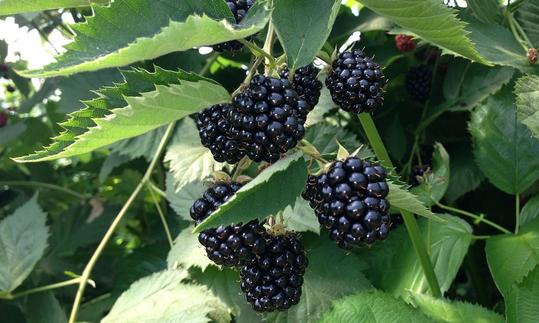

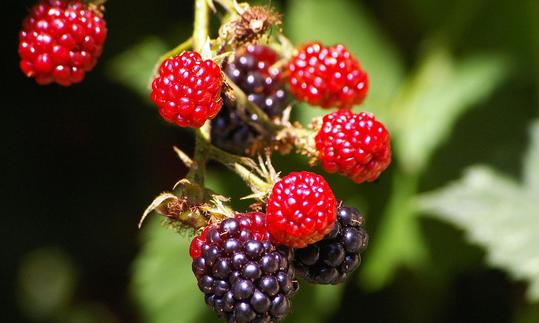

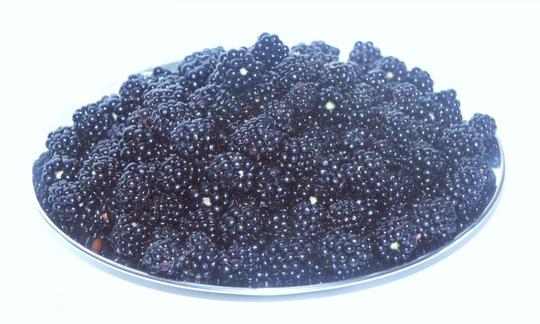

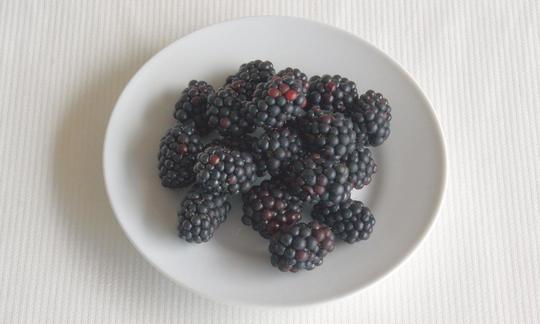

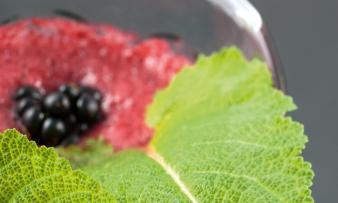





Comments